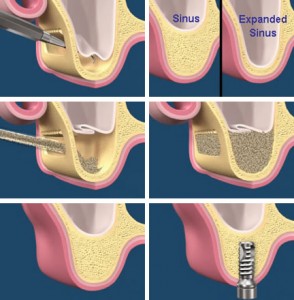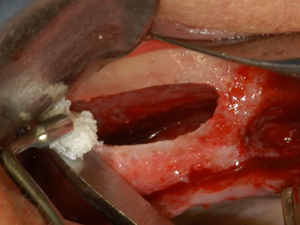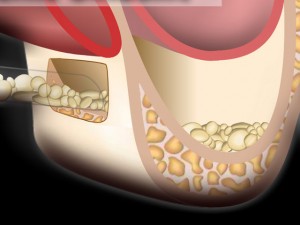972-241-4433
What Is It?
A sinus lift is surgery that adds bone to your upper jaw in the area of your molars and premolars. It’s sometimes called a sinus augmentation. The bone is added between your jaw and the maxillary sinuses, which are on either side of your nose. To make room for the bone, the sinus membrane has to be moved upward, or “lifted.” In our office Dr. Haghiri herself will do the operation. Knowing our patient’s medical and dental background, she will make sure that the patient is in a calm state before she starts the procedure.
Even though it depends on the patient, nobody will be calm on a dentist chair unless he/she is confident about the dentist operating on them! For that reason alone, we invite you to our office to have a FREE evaluation with Dr. Haghiri and our staff. During your first evaluation, Dr. Haghiri will assess your case using a Panoramic X-ray or a Cat-scan, she will go over your medical back ground, and if you are a good candidate for sinus lift and bone graft treatment, our front office staff will schedule your surgery.

Actual result may vary
What It’s Used For:
A sinus lift is done when there is not enough bone in the upper jaw, or the sinuses are too close to the jaw, for dental implants to be placed. There are several reasons for this:
- Many people who have lost teeth in their upper jaw — particularly the back teeth, or molars — do not have enough bone for implants to be placed. Because of the anatomy of the skull, the back of the upper jaw has less bone than the lower jaw.
- Bone may have been lost because of periodontal (gum) disease.
- Tooth loss may have led to a loss of bone as well. Once teeth are gone, bone begins to be resorbed (absorbed back into the body). If teeth have been missing for a long time, there often is not enough bone left to place implants.
- The maxillary sinus may be too close to the upper jaw for implants to be placed. The shape and the size of this sinus varies from person to person. The sinus also can get larger as you age.
Sinus lifts have become common during the last 15 years as more people get dental implants to replace missing teeth.
Preparation
The bone used in a sinus lift may come from your own body (autogenous bone) or from a cadaver (allogeneic bone).
If your own bone will be used in the sinus lift, it will be taken from other areas of your mouth or body. In some cases, the surgeon removes bone from your hip or tibia (the bone beneath the knee).
You may need X-rays taken before your sinus lift so the dentist can study the anatomy of your jaw and sinus. You also may need a special type of computed tomography (CT) scan. This scan will allow the dentist to accurately measure the height and width of your existing bone and to evaluate the health of your sinus.

How It’s Done
Dr. Hagiri will cut the gum tissue where your back teeth used to be. The tissue is raised, exposing the bone. A small, oval window is opened in the bone. The membrane lining the sinus on the other side of the window separates your sinus from your jaw. This membrane is gently pushed up and away from your jaw.
Granules of bone-graft material are then packed into the space where the sinus was. The amount of bone used will vary, but usually several millimeters of bone is added above the jaw.
Once the bone is in place, the tissue is stitched closed. Your implants will be placed four to nine months later. This allows time for the grafted material to mesh with your bone. The amount of time depends on the graft material that was used.
Follow-Up
After the procedure, you may have some swelling of the area. You may bleed from your mouth or nose. Do not blow your nose or sneeze forcefully. Either one could cause the bone-graft material to move, and loosen the stitches.
Your dentist may give you saline sprays to keep the inner lining of your nose wet and prescribe medicine to prevent sneezing. If you have seasonal allergies, you should schedule the procedure when they are not active. You also will be given pain medicine, an antibiotic and an antimicrobial mouthwash to help prevent infection. Most patients have only a little discomfort after a sinus-lift procedure.
Dr. Haghiri will need to see you after 7 to 10 days. She will evaluate the surgical site and possibly remove stitches. You probably will be asked to return a few more times to make sure the area is healing properly.
After a sinus lift, you need to wait several months for the bony material to harden and integrate with your jaw. Depending on the grafting material used, implants may be placed in four to nine months.
Based on your case Dr. Haghiri might use proteins called growth factors to help the new bone harden faster. Platelet-rich plasma, which contains the growth factors, is taken from your blood before surgery and mixed with the graft that is placed into your sinus. Human-recombinant bone morphogenetic protein is an engineered protein that is now available. It stimulates bone formation without grafting.
Risks
The main risk of a sinus lift is that the sinus membrane could be punctured or torn. If the membrane is torn during the procedure, Dr. Haghiri will either stitch the sinus tear or place a patch over it. If the repair is not successful, Dr. Haghiri may stop the procedure and give the hole time to heal. Dr. Haghiri can redo the sinus lift once the membrane has healed. This usually takes a few months. A healed membrane tends to be thicker and stronger, which means a second attempt at a sinus lift is likely to be successful. However, other factors also affect success.
Infection is a risk of any surgical procedure. However, this rarely occurs after sinus lifts.
On rare occasions, the existing bone does not integrate with the bony graft material, and the grafted area does not develop a blood supply. If this happens, any implants placed in this area will fail because there is no live bone for them to attach to. If this happens, you can have the sinus lift procedure repeated.
When To Call Dr. Haghiri:
After a sinus lift, contact American Dental if:
- Any swelling or pain gets worse over time. (It should decrease after the first two days or so.)
- The bleeding does not stop after one to two days.
- You think the bony material may have been dislodged after sneezing or blowing your nose.
- Pain does not decrease over time.
- You develop a fever.
